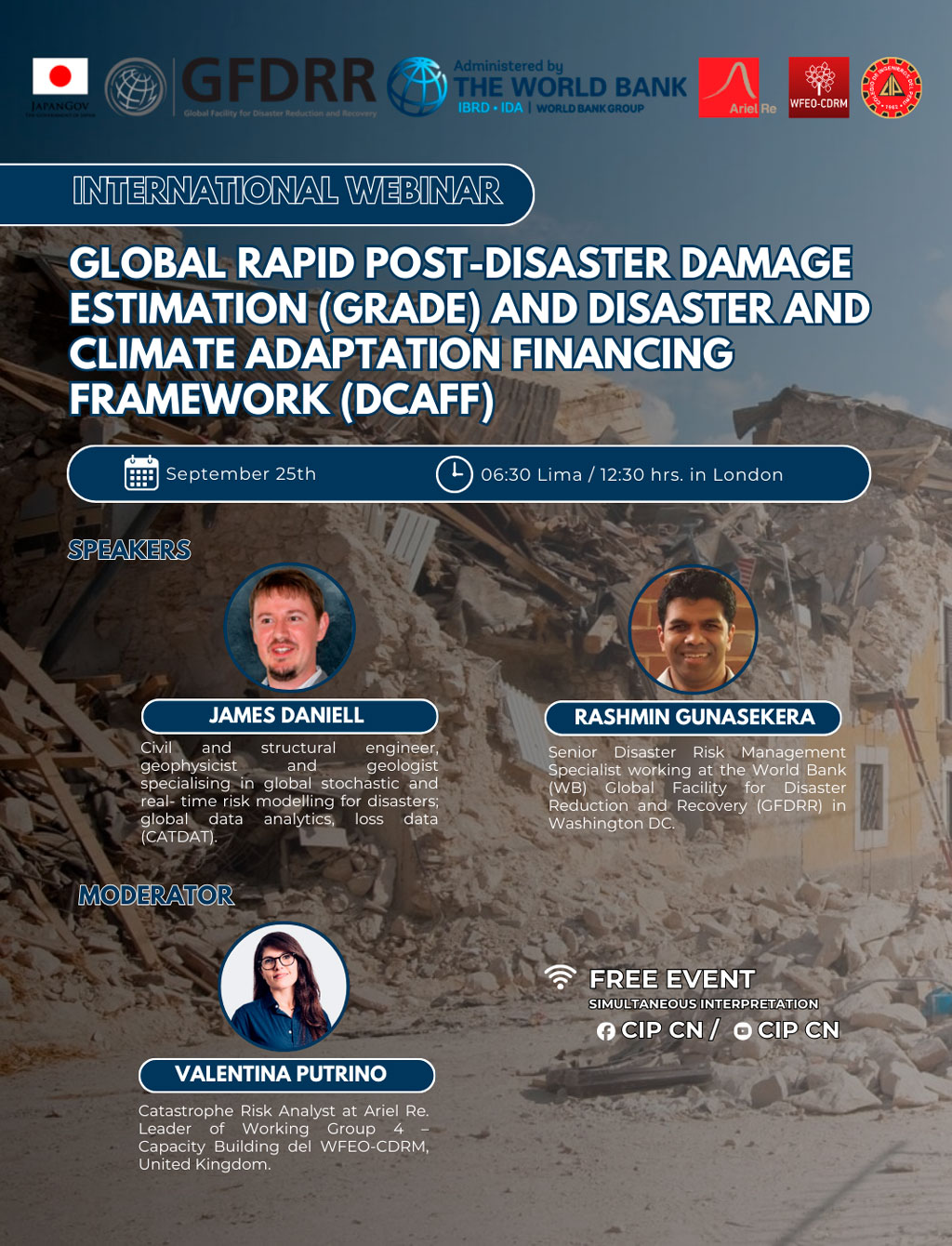
INTERNATIONAL WEBINAR
GLOBAL RAPID POST-DISASTER DAMAGE ESTIMATION (GRADE)
AND
DISASTER AND CLIMATE ADAPTATION FINANCING FRAMEWORK (DCAFF)
The Technical Committee on Disaster Risk Management of the World Federation of Engineering Organizations (WFEO) and the Peruvian Engineers Association (CIP) are organizing this important event to be held on September 25th, at 06:30 hrs. in Lima and 12:30 hrs. in London
Disasters are no longer isolated shocks; they are recurring fiscal liabilities. The damage disproportionately affected vulnerable countries with weak construction standards, limited access to resources, and insufficient institutional capacity. Housing, infrastructure, and agriculture tend to suffer the greatest damage, leaving national economies reeling for years.
GRADE is a remote, desk-based methodology developed by the World Bank and implemented by GFDRR to help World Bank member countries estimate the economic damage impact soon after disasters. Since its first application after the 2015 Nepal Earthquake, it has been used in over 70 occasions in response to disasters in over 50 countries has informed recovery planning
faster mobilization of funds. Using disruptive technology, GRADE assessments are developed in approximately a couple of weeks’ time and on average to accuracy of 90 percent of detailed on the ground damage assessments that follow later. The information generated from GRADE has become a trusted tool for Ministries of Finances, DRM agencies as well as decision makers including World Bank to understand the overall impacts from disasters.
We also need to invest in ex-ante measures in Disaster Risk Management. Despite investments in physical risk reduction and climate adaptation measures taking place, their resultant increased financial resilience benefits are not being adequately captured nor optimally leveraged. This also means that disaster related financial protection gaps 1 of countries are also not being reduced efficiently. By addressing both physical risk (structural) and financial vulnerabilities, and buttressing the ecosystem that enables implementation, DCAFF enables countries to prepare for and mitigate disaster impacts more effectively. This session will explain the DCAFF program, developed by the World Bank and GFDRR. By addressing both physical risk (structural) and financial vulnerabilities, and buttressing the ecosystem that enables implementation, DCAFF enables countries to prepare for and mitigate disaster impacts more effectively.
This seminar will review the experience of GRADE assessments from the last 10 years including experience of recent assessments. It will also highlight current trends in DRM such as with the DCAFF program.
PROGRAMME
OUR SPEAKERS
 |
James Daniell is a John Monash Scholar of Australia. He is a civil and structural engineer, geophysicist and geologist specialising in global stochastic and real-time risk modelling for disasters; global data analytics, loss data (CATDAT), building codes, exposure and socioeconomic models over the last two decades for various entities including governments, insurers, reinsurers, universities and other companies. He works on projects as a Lead Disaster Risk Analyst within the World Bank/GFDRR globally, primarily working on rapid damage estimation after catastrophes (GRADE), Country Disaster Risk Profiles and other risk models in many locations, as well as building open software solutions. He is a Professor (adjunct) at University of Adelaide and Senior Researcher at Karlsruhe Institute of Technology (where he earlier did his PhD in rapid loss analytics (Dr.-Ing.)). |
 |
Rashmin Gunasekera is a Senior Disaster Risk Management Specialist working at the World Bank (WB) Global Facility for Disaster Reduction and Recovery (GFDRR) in Washington DC. Rashmin leads two Global thematic areas of Disaster Risk Analytics (GPDRA) and Disaster Risk Financing & Resilience (DRF&R) at GFDRR. Rashmin has over 20 years of work experience in disaster risk quantification with the public sector, re/insurance industry and academia. Prior to the WB, Rashmin was a Divisional Director of a global reinsurance intermediary and a coordinator of the Willis Research Network, the world’s largest collaboration between public science and the financial sector. A Sri Lankan and British national, his PhD is in earthquake seismology and he holds a Visiting Professorship at University of Cambridge and Honorary Lectureship at UCL. |
OUR MODERATOR
 |
Dr Valentina Putrino is currently a Catastrophe Risk Analyst at Ariel Re. She obtained her PhD from University College London (UCL), focusing on developing a framework for multi-hazard assessment of historic stonework structures. She currently holds the position of Chair of the EEFIT Committee, she is the SECED Representative for the World Federation of Engineering Organizations (WFEO) – Committee on Disaster Risk Management (CDRM) and is also the designated liaison member between both SECED and EEFIT committees. |

